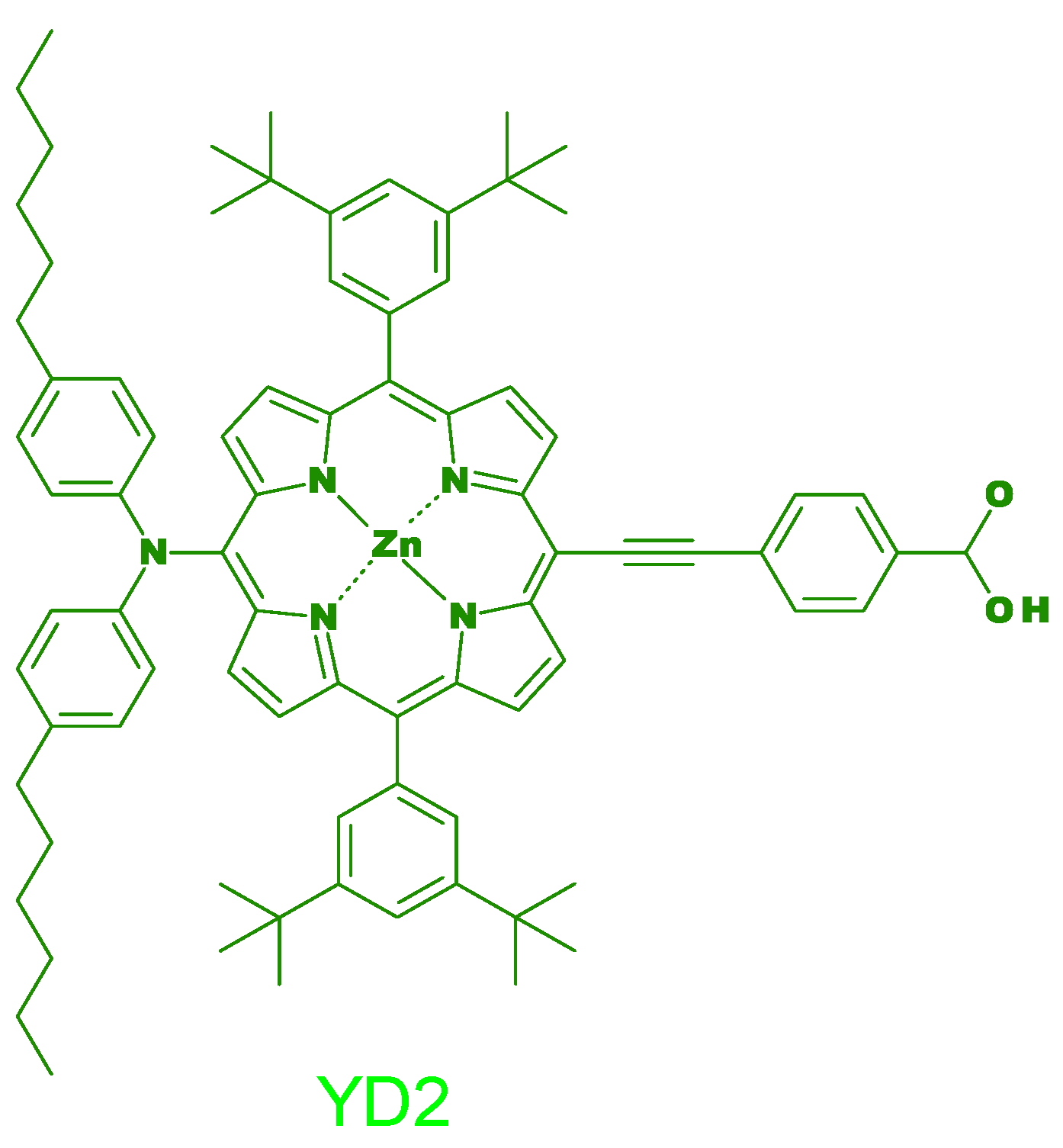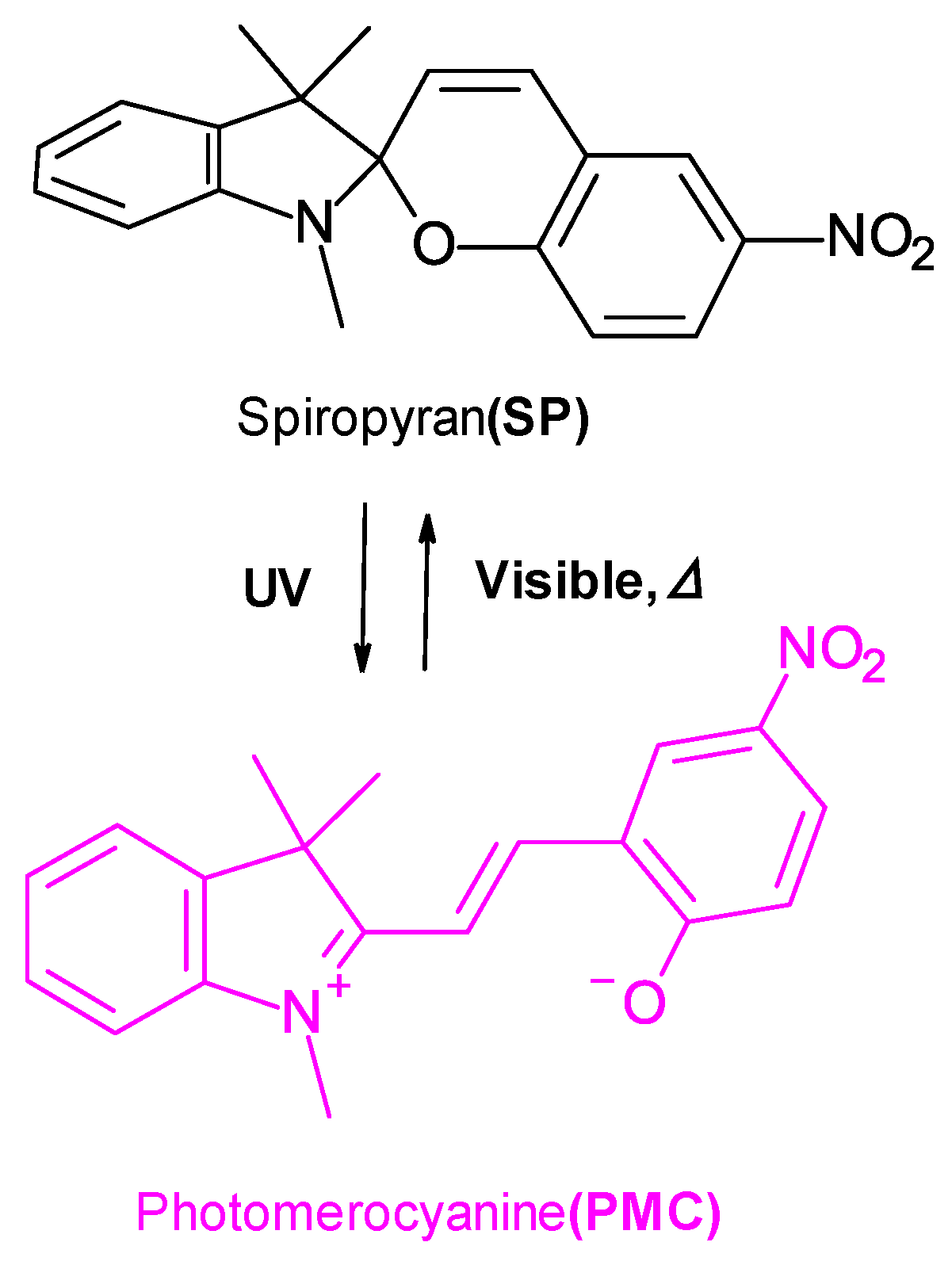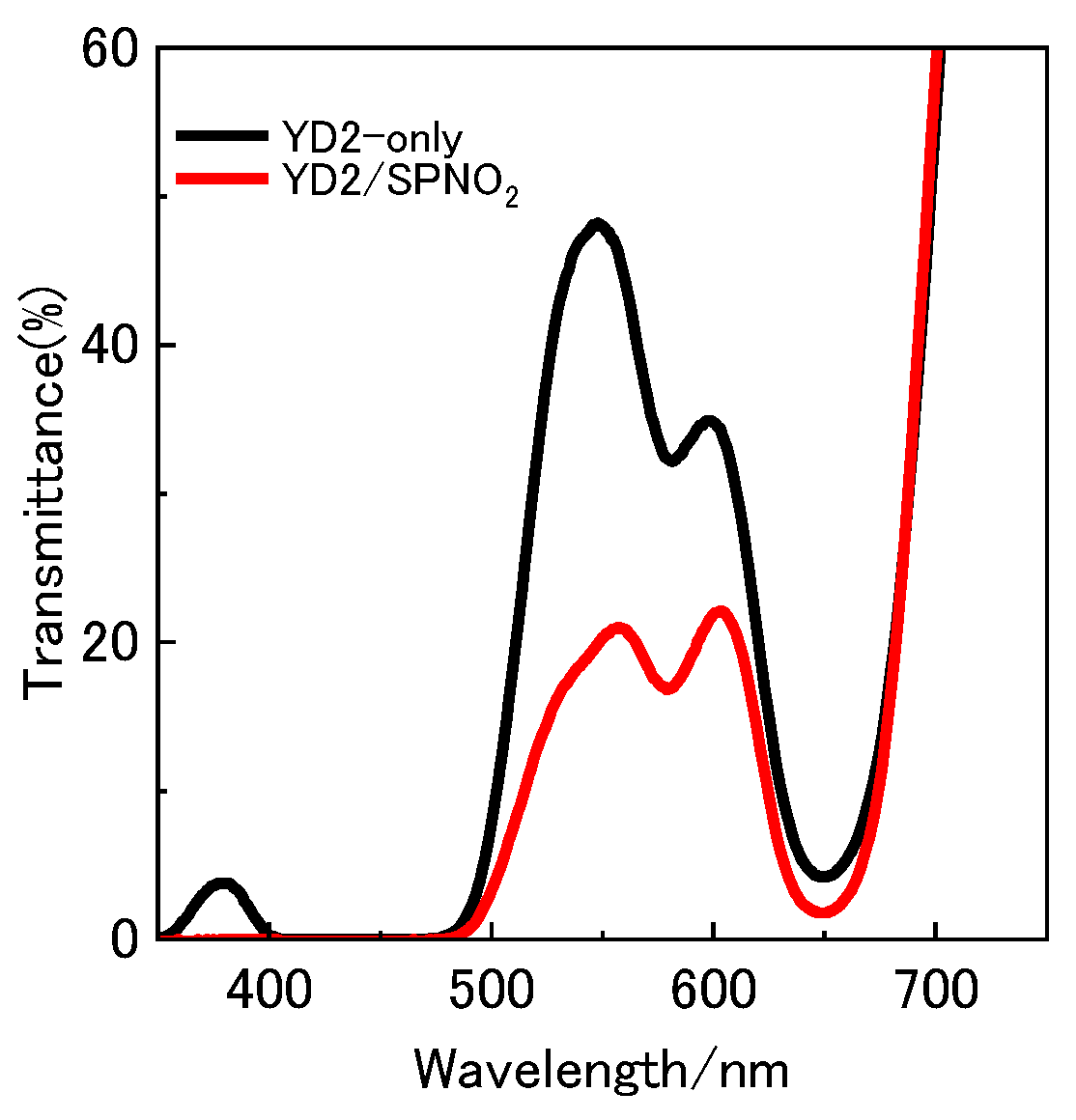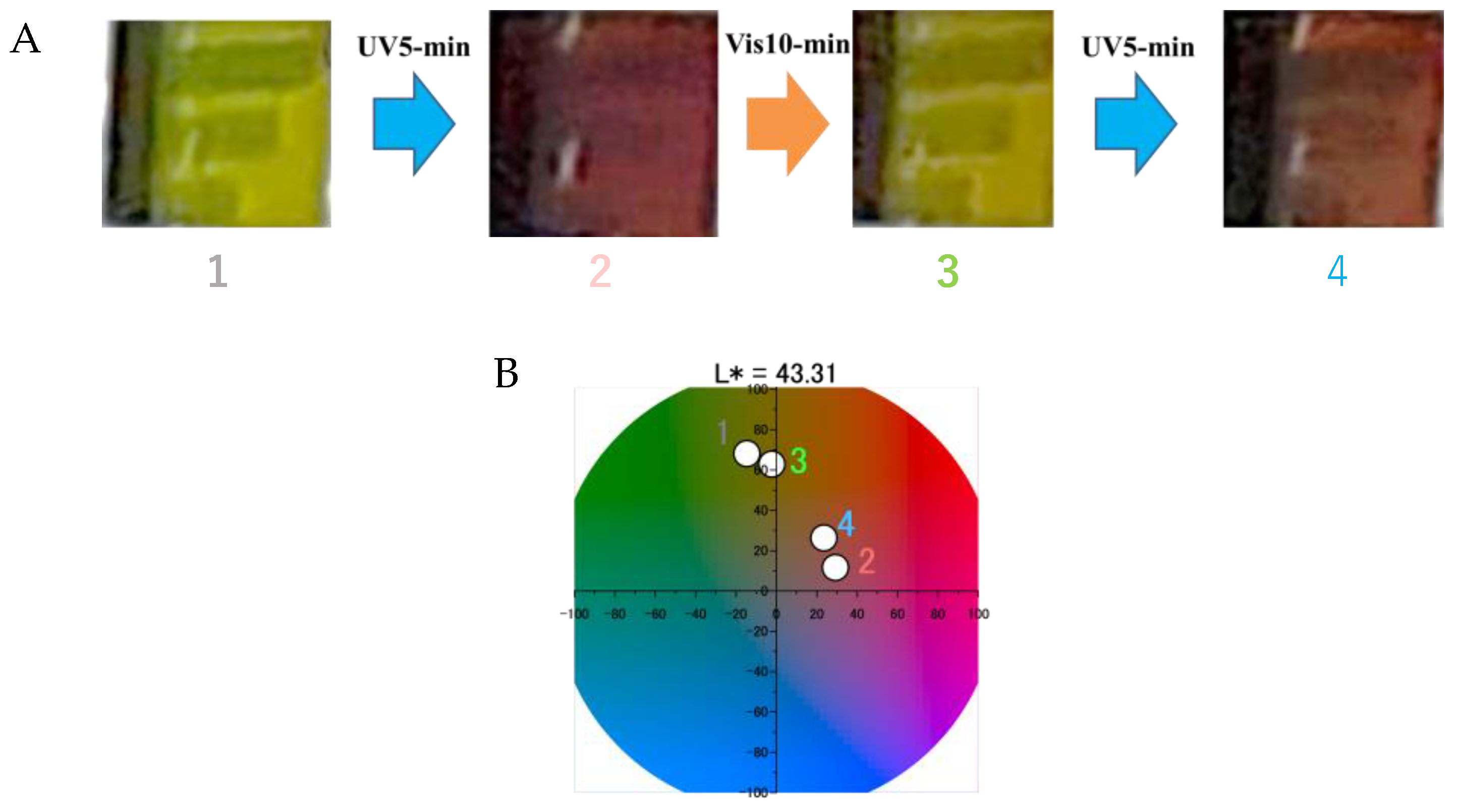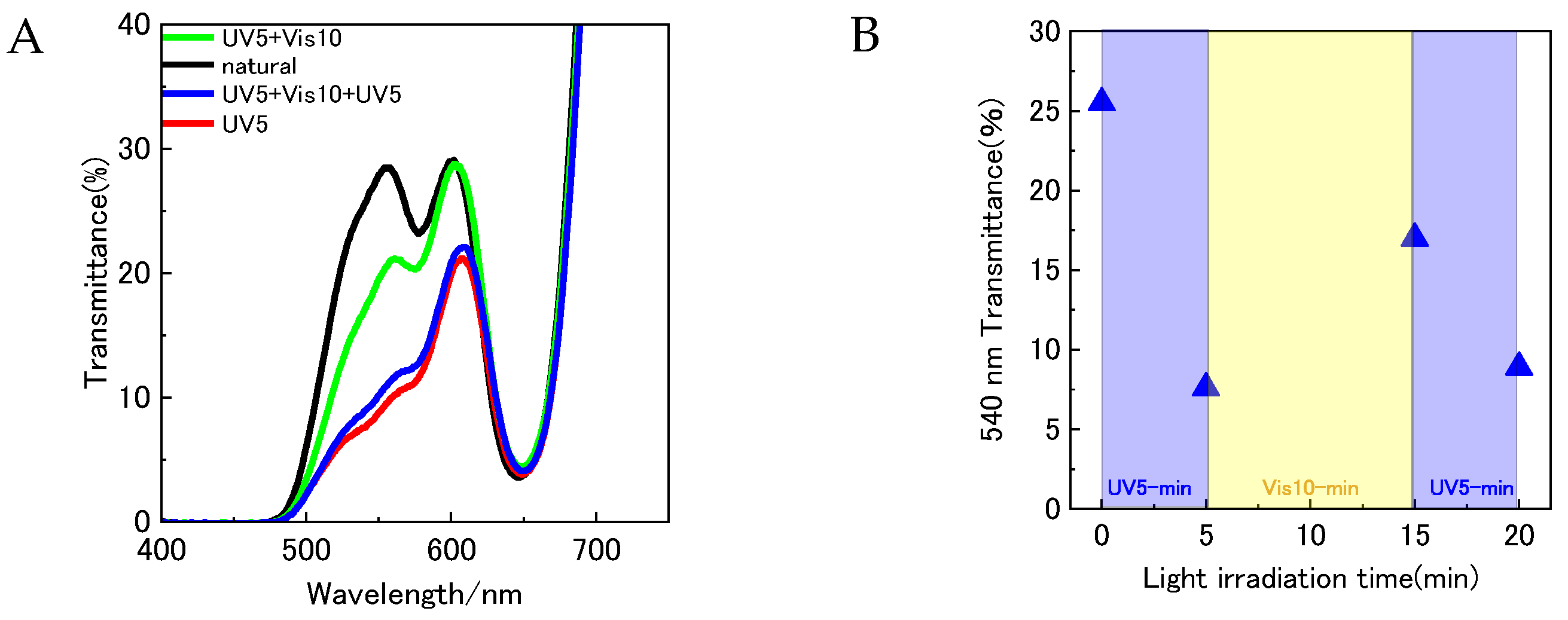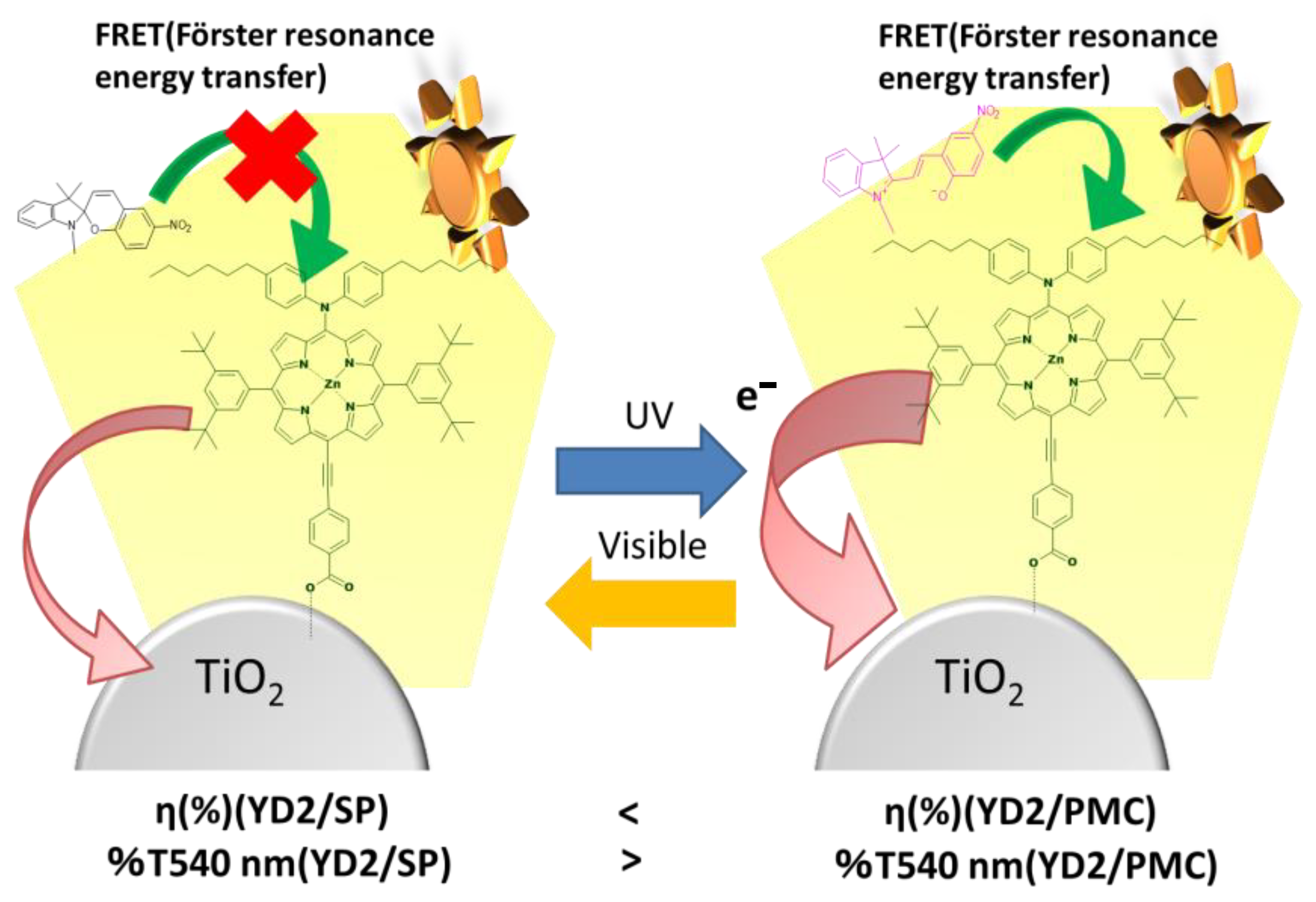1. Introduction
As a representative class of emerging photovoltaic technologies, dye-sensitized solar cells (DSSCs) have attracted considerable attention due to their economical fabrication, tunable optical features, such as coloration and semi-transparency, mechanical compliance, and satisfactory energy conversion capability, making them viable candidates for integration into applications beyond traditional silicon photovoltaics [
1,
2,
3,
4,
5,
6,
7,
8]. Recent advances have enabled DSSCs to achieve power conversion efficiency (PCE) as high as 15.2% under AM 1.5G standard solar illumination [
8]. Among the various organic sensitizers developed for DSSCs, the zinc porphyrin derivative known as YD2 (
Figure 1), formally designated as [5-[Bis(4-hexylphenyl)amino]-1,5-[2-(4-carboxyphenyl)ethynyl]-10,20-bis(3,5-di-tert-butylphenyl)porphyrinato]zinc(II), stands out due to its strong and broad absorption across the visible spectrum, high molar absorptivity [
1], and favorable alignment for electron injection into TiO
2-based photoanodes. Its relatively simple architecture and reduced dependence on rare elements also make YD2 a cost-effective option. Notably, DSSCs incorporating YD2 have demonstrated PCEs reaching up to 11.0% [
9]. To further improve device performance, co-sensitization strategies have been explored wherein YD2 is paired with complementary dyes. For instance, dye mixtures combining YD2 and ZnPc3 in a 3:1 ratio have been shown to broaden the light absorption window and enhance charge separation [
9,
10,
11]. The broader importance of co-sensitization strategies in DSSCs has been highlighted in both early and recent studies. A systematic analysis of co-sensitization effects was reported by Zhang et al., demonstrating how complementary dye combinations can significantly influence charge injection and overall device efficiency [
12]. More comprehensive reviews have summarized the progress and design principles of co-sensitized DSSCs, emphasizing molecular compatibility, spectral complementarity, and interfacial charge dynamics [
13]. Building on these foundations, Keremane et al. recently investigated co-sensitization effects in detail using new dye architectures, providing fresh insights into light-harvesting mechanisms and stability enhancement [
14]. Together, these works establish co-sensitization as a robust and versatile approach to improving DSSC performance. Additionally, Förster resonance energy transfer (FRET) has emerged as a promising mechanism to facilitate exciton migration and improve charge generation efficiency in co-sensitized systems [
15,
16,
17,
18,
19,
20]. Beyond chemical optimization, external stimuli such as mechanical compression, magnetic fields, thermal activation, and light irradiation have also been investigated to dynamically modulate DSSC behavior [
21,
22,
23,
24]. In this study, we report on DSSCs co-sensitized with YD2 and the photochromic spiropyran derivative SPNO
2 (
Figure 2), examining their reversible modulation of optical absorption and photovoltaic performance under alternating UV and visible light exposure.
Photochromic molecules, particularly spiropyran derivatives, have been studied as functional additives in dye-sensitized solar cells (DSSCs) due to their ability to reversibly alter both optical appearance and photovoltaic performance in response to external light stimuli [
23,
25,
26]. For example, Dryza and co-workers examined the photochemical behavior of 1,3,3-trimethylindolino-6′-nitrobenzopyrylospiran (SPNO
2) embedded within γ-cyclodextrin cavities on metal oxide nanoparticle substrates. Under ultraviolet (UV) irradiation, SPNO
2 undergoes a reversible transformation from the non-absorbing spiro (SP) form to the colored photomerocyanine (PMC) form (
Figure 2), which changes the absorption characteristics and may interact with neighboring sensitizers such as YD2. In particular, Förster resonance energy transfer (FRET) to SQ2—a squaraine-based dye recognized for its strong absorption in the visible spectrum and efficient electron injection—has been suggested [
27]. In our earlier work, we provided detailed characterization of SPNO
2’s isomerization and optical switching within SQ2-based DSSCs [
28]. Departing from that context, this study focuses on YD2-based cells to investigate the role of SPNO
2 as a co-sensitizer with tunable optical and electronic behavior. We previously demonstrated that combining SPNO
2 with SQ2 allowed control over both coloration and power output through light irradiation [
28]. Extending that concept, we now apply a similar strategy to YD2-only systems, capitalizing on YD2’s strong absorption and high photovoltaic capability. Accordingly, DSSCs incorporating both YD2 and SPNO
2 were fabricated and evaluated for light-responsive modulation. The SPNO
2 component serves as a photoresponsive sensitizer, undergoing reversible interconversion between the SP and PMC forms when exposed to UV or visible light. We propose that FRET from PMC to YD2 facilitates tunable absorption behavior and enhances photoinduced charge separation. To validate this, we conducted spectral and electrical measurements under alternating illumination and assessed FRET efficiency through fluorescence lifetime analysis using photoanodes sensitized with PMC, either alone or combined with YD2.
2. Materials and Methods
All chemicals and solvents utilized in this study were either analytical- or spectroscopic-grade and were used without additional purification. The TiO2 paste (Ti-nanoxide T/SP), iodide-based electrolyte solution (Iodolyte Z-50), and the porphyrin dye YD2 were obtained from Solaronix (Aubonne, Switzerland). The photochromic compound 1,3,3-trimethylindolino-6′-nitrobenzopyrylo-spiran (SPNO2) was purchased from Tokyo Kasei (Tokyo, Japan). Fluorine-doped tin oxide (FTO) glass substrates (sheet resistance: 9.3 Ω/□) were provided by Asahi Glass Co., Ltd. (Tokyo, Japan) Spectroscopy-grade benzene and ethanol were sourced from Wako Pure Chemical Industries (Odawara, Japan).
Photoanode fabrication involved depositing TiO2 paste onto FTO glass using the doctor-blade method. After coating, the substrates were gradually heated in air to 450 °C over 50 min and sintered at that temperature for 1 h. The resulting mesoporous TiO2 films had a circular photoactive area approximately 0.6 cm in diameter.
Two types of photoanodes were prepared: one sensitized only with YD2 and the other co-sensitized with both YD2 and SPNO2. For the former, TiO2 electrodes were immersed in an ethanolic YD2 solution (3.0 × 10−4 M) at room temperature for 24 h. For co-sensitization, these YD2-loaded electrodes were additionally soaked in a 0.16 M benzene solution of SPNO2 for 30 min.
Counter electrodes were prepared by depositing a platinum layer onto clean FTO glass via sputtering in an argon environment. The final DSSCs were assembled in a sandwich-like configuration using an 80 μm thick thermoplastic film (Roland DGS-305-BK, Roland DG Corporation, Shizuoka, Japan) as a spacer. Electrolyte infiltration between electrodes was achieved through capillary action.
The optical absorption spectra of photoanodes were recorded with a UV-Vis spectrophotometer (Hitachi U-3310, Hitachi High-Tech Corporation, Tokyo, Japan). Emission spectra and fluorescence lifetimes (τ) were measured using a fluorescence spectrometer (PerkinElmer LS55, PerkinElmer, Inc., Shelton, CT, USA) and a time-resolved fluorescence spectrometer (Hamamatsu C11367, Hamamatsu Photonics K.K., Hamamatsu City, Japan), respectively.
Photovoltaic performance was evaluated under AM1.5 simulated sunlight using a 500 W xenon lamp (Ushio SX-UI502XQ, Ushio Inc., Tokyo, Japan), with light intensity calibrated via a Melles Griot 13PEM001 power meter (Melles Griot, Boulder, CO, USA). J–V curves were obtained with a source-measure unit (Advantest R6243, Advantest Corporation, Yokohama-shi, Japan), while monochromatic J–V testing was performed using a Keysight B2901A (Keysight Technologies Inc., Santa Rosa, CA, USA) source and MT10-T monochromator (Bunkoukeiki, Tokyo, Japan). Illumination intensity was validated with Thorlabs PM400 (Thorlabs, Inc., Newton, NJ, USA) and Melles Griot power meters (Melles Griot, Boulder, CO, USA).
External light-responsive tests involved exposure to UV and visible light from an Alfa Mirage MR-UV system, delivering doses of 6 J (UV) and 90 J (Vis), respectively. All measurements were carried out at room temperature. During solar performance evaluations, a 0.16 cm2 aperture mask defined the active cell area. Device metrics including short-circuit current density (Jsc), open-circuit voltage (Voc), fill factor (FF), overall power conversion efficiency (η), and incident photon-to-current efficiency (IPCE) were assessed. Data analysis and visualization were conducted using Origin® 2023b (OriginLab, Northampton, MA, USA).
3. Results and Discussion
Upon immersing the TiO
2 photoelectrode in a benzene solution containing YD2-only, the electrode surface quickly shifted from colorless to green. As illustrated in
Figure 3, this change was accompanied by a transmittance spectrum featuring an absorption band spanning 300–750 nm. This spectral feature aligns with the characteristic absorption of YD2-only in benzene, implying that YD2-only molecules were successfully adsorbed onto the TiO
2 surface. Subsequent immersion of the YD2-only coated electrode in a benzene solution containing SPNO
2 resulted in further spectral changes, with a noticeable reduction in transmittance observed around 500–650 nm (red trace in
Figure 3). In addition, the electrode’s appearance changed from green to a reddish-green hue, suggesting the adsorption of SPNO
2 onto the YD2-only anchored surface. SPNO
2 exhibits absorption in the visible region, where its isomers—SP and PMC—have peak absorptions at approximately 350 nm and 540 nm, respectively. Therefore, the observed decline in transmittance between 540–560 nm can be specifically attributed to the formation of the PMC isomer upon UV irradiation, confirming its photoconversion on the electrode surface.
The current–voltage (
J–
V) characteristics of DSSCs incorporating YD2-only alone and co-sensitized with YD2/SPNO
2 were measured under AM1.5 illumination, as shown by the black and red curves in
Figure 4A. The data confirm that electron injection from YD2-only into the conduction band of TiO
2 nanoparticles was effectively promoted via its photosensitization. The energy conversion efficiencies (η) for the devices containing only YD2-only and those co-sensitized with YD2/SPNO
2 were found to be 1.24% and 0.71%, respectively. This decrease in efficiency is likely due to the reduced light absorption by YD2-only, which may be caused by surface adsorption of SPNO
2 (both SP and PMC forms) on the electrode.
The incident photon-to-current efficiency (IPCE) spectra of DSSCs incorporating YD2-only alone and those co-sensitized with YD2/SPNO
2 were recorded under illumination in the 400–800 nm wavelength range (
Figure 4B, black and red curves). A prominent peak appears at approximately 440 nm, and the overall spectral profile resembles the transmittance behavior of YD2-only adsorbed on TiO
2.
The surface color of the photoelectrode containing both YD2/SPNO
2 exhibited dynamic changes upon alternating light irradiation, as shown in the inset in
Figure 5. Following 5 min of UV exposure, the initially green electrode turned red; subsequent visible light irradiation for 10 min restored the green coloration, which again shifted to red after an additional 5-min UV treatment. The electrode appeared green at the outset due to the presence of green-colored YD2-only and the nearly transparent SP form of SPNO
2 adsorbed on TiO
2 [
22,
26]. Upon UV irradiation, the formation of the red-colored isomer PMC from SPNO
2 accounted for the reddish hue, while YD2-only retained its original green appearance [
22,
26].
Upon immersing the YD2-only coated TiO
2 photoelectrode in a benzene solution containing SPNO
2, its surface color rapidly shifted from green to a reddish-green hue. The corresponding transmittance spectrum (black line in
Figure 6) displayed near-zero transmittance in the 400–500 nm region. As also seen in
Figure 3, this spectral pattern closely corresponds to the absorption characteristics of YD2-only in benzene, indicating a physical interaction—likely physisorption—between SPNO
2 and the pre-adsorbed YD2-only layer.
Figure 6A presents the transmittance spectra of the YD2/SPNO
2-modified photoelectrode following sequential light exposures: 5 min of UV (red), 10 min of visible light (green), and an additional 5 min of UV (blue).
Figure 6B highlights the variation in transmittance at 540 nm for each of these conditions. The PMC isomer, which absorbs at this wavelength, exhibited an 18% decrease in transmittance after the first UV irradiation, followed by a 10% recovery upon visible light exposure, and then a further 7.5% reduction after the final UV irradiation. These fluctuations at 540 nm support the reversible formation of the PMC isomer on the TiO
2 surface in response to alternating light stimuli.
Figure 7A (black markers) shows the current–voltage (
J–
V) characteristics of DSSCs incorporating both YD2/SPNO
2 under AM1.5 simulated sunlight. The measurements indicate that YD2-only facilitated electron injection into the conduction band of TiO
2 nanoparticles through its photosensitizing function. The device’s photovoltaic behavior was also evaluated under different external light conditions: UV irradiation for 5 min, visible light for 10 min, and a subsequent 5-min UV exposure (red, green, and blue markers in
Figure 7A, respectively). The corresponding energy conversion efficiencies (η), derived from
Figure 7B, changed in sequence from 0.70% to 1.21%, then dropped to 0.38%, and slightly increased to 0.45% with alternating light exposure. These findings suggest that the PMC isomer absorbs light and contributes to photocurrent generation, thereby functioning as a photosensitizer. The error bars in
Figure 7B represent the standard deviation calculated from three independently fabricated DSSC devices per condition. Furthermore, the short-circuit current density (
Jsc), open-circuit voltage (
Voc), fill factor (FF), and overall efficiency (η) were extracted from the
J–
V data and are summarized in
Table 1.
The YD2/SPNO2-based dye-sensitized solar cell (DSSC) demonstrated photovoltaic parameters of Jsc = 2.2 mA cm−2, Voc = 0.54 V, FF = 0.51, and an energy conversion efficiency (η) of 0.70% under standard conditions. To examine the device’s response to external optical stimuli, it was sequentially exposed to ultraviolet and visible light. The evolution of η followed the trend 0.70% (natural) → 1.21% (UV for 5 min) → 0.38% (UV 5 + Vis 10 min) → 0.45% (UV 5 + Vis 10 + UV 5 min). Similarly, the short-circuit current density (Jsc) varied under the same series of light exposures as follows: 2.2 → 3.4 → 1.6 → 1.9 mA cm−2. These results indicate that both η and Jsc increased upon UV irradiation and decreased following visible light exposure. In contrast, Voc and FF remained nearly constant throughout the irradiation cycles. This suggests that the modulation of η primarily stems from changes in Jsc. Interestingly, although Jsc increased by approximately 54.5% after UV exposure, the corresponding transmittance dropped by 18.5%, implying that the relationship between light absorption and photocurrent generation is not strictly linear. Taken together, these findings support the hypothesis that PMC contributes to photocurrent generation by functioning as a light-absorbing sensitizer.
To evaluate the photoelectric conversion performance of DSSCs co-sensitized with YD2/SPNO
2, incident photon-to-current efficiency (IPCE) spectra were recorded over the 400–800 nm wavelength range, as shown in
Figure 7C. The maximum IPCE value reached approximately 27% at 440 nm.
Figure 7C (red, green, and blue markers) also illustrates the spectral changes under successive external light exposures: UV for 5 min, visible light for 10 min, and a second UV irradiation for 5 min. Following UV irradiation, the IPCE values increased across the 400–700 nm range, while subsequent exposure to visible light led to a decline in this region. These observations imply that the concentration of the PMC isomer increases after UV exposure and diminishes after visible light irradiation. This reversible behavior suggests that PMC contributes to the modulation of photovoltaic efficiency in the co-sensitized device.
The YD2-only dye anchors to the TiO
2 surface through ester linkages formed between its carboxyl functional groups and surface hydroxyls on the TiO
2 nanoparticles [
25,
26]. This molecular interaction facilitates efficient electron transfer from YD2-only to the conduction band of TiO
2, resulting in a photovoltaic conversion efficiency of approximately 1.24% in DSSCs, utilizing YD2-only as the primary sensitizer.
Upon ultraviolet (UV) irradiation, SPNO
2 undergoes a structural transformation from its closed spiropyran (SP) form to the ring-opened photomerocyanine (PMC) form. This photoisomerization induces a visible color change in the TiO
2-based photoelectrode, shifting from green to reddish tones, which is accompanied by a decrease in transmittance near 540 nm due to the absorption characteristics of PMC. The resulting dye-sensitized solar cells (DSSCs), fabricated with UV-treated electrodes, exhibited an improvement in power conversion efficiency (η). Subsequent exposure to visible light caused PMC to revert to the original SP form, leading to a recovery of the electrode’s green appearance and a corresponding decline in η. These observations suggest that the optical and photovoltaic properties of the device are closely linked to the isomeric state of SPNO
2. Additionally, no significant Förster energy transfer from SPNO
2 to YD2-only was detected, indicating that the effect of PMC on device performance may arise through indirect modulation (
Figure 8). While Takeshita et al. [
23] have previously explored the photovoltaic behavior of PMC, their results indicate that direct electron injection from PMC into the conduction band of TiO
2 is energetically unfavorable. Thus, we infer that neither SP nor PMC serves as an active electron donor in the charge injection process within the TiO
2 network.
Although definitive experimental evidence for Förster resonance energy transfer (FRET) from the PMC isomer to YD2-only remains elusive, time-resolved fluorescence data suggest a possible energy transfer pathway. Specifically, we observed a reduction in fluorescence lifetime from 0.90 ns (PMC-TiO
2) to 0.41 ns (PMC–YD2-only–TiO
2), which may imply donor quenching due to proximity-based energy transfer. This observation aligns with previous findings [
26] in which SPNO
2 acted as a FRET donor to another dye (SQ2), although that study did not include YD2.
To further probe this phenomenon, the FRET efficiency (ΦFRET) was estimated using average fluorescence lifetimes according to the relation ΦFRET = 1 − (τDA/τD), where τD and τDA are the lifetimes of PMC in the absence and presence of YD2, respectively. This analysis yielded a ΦFRET of approximately 0.54, supporting the possibility of energy transfer within our co-sensitized architecture.
We propose that UV irradiation promotes SPNO
2 isomerization from the non-planar SP form to the conjugated PMC form, which acts as a FRET donor to YD2-only, enhancing light-harvesting and improving photocurrent generation. Conversely, exposure to visible light induces reverse isomerization (PMC → SP), diminishing the energy transfer process and consequently reducing efficiency (η). These results collectively suggest a dynamic FRET-mediated mechanism modulating device performance under light stimuli, although further spectroscopic studies are warranted to conclusively validate this model. Additionally, based on energy level estimations reported by Dryza et al., the lowest unoccupied molecular orbital (LUMO) of PMC (~−4.0 eV) lies below the conduction band of TiO
2, making direct electron injection energetically unfavorable. This reinforces the hypothesis that PMC serves primarily as an energy donor rather than an electron injector in our DSSC system [
27].
Beyond the mechanistic insights, the demonstration of a reversible, light-tunable photovoltaic response provides a conceptual basis for developing adaptive energy devices. Compared with conventional co-sensitization approaches that primarily broaden spectral coverage, the YD2/SPNO2 system offers an additional dimension of dynamic control. Such functionality could be particularly advantageous for semi-transparent DSSCs in building-integrated photovoltaics (BIPVs), where color tuning and light management are as important as efficiency. Furthermore, the present results suggest a broader design principle in which photochromic sensitizers can be rationally combined with porphyrin dyes to achieve multifunctional, responsive solar cells.
